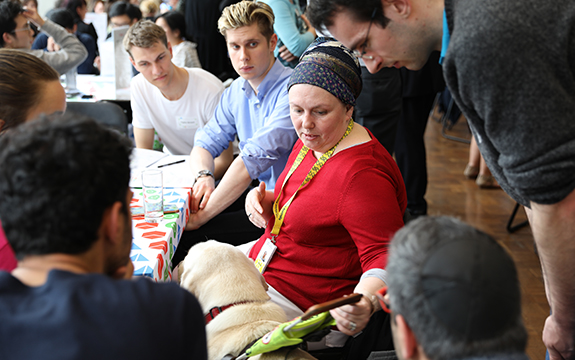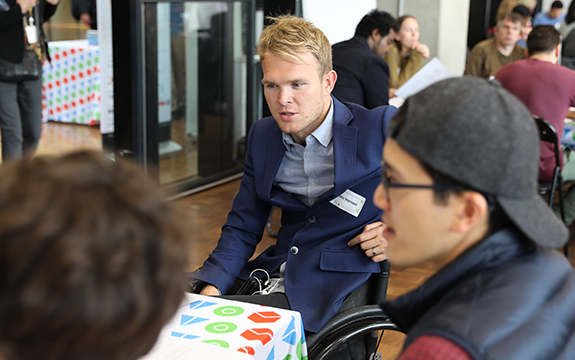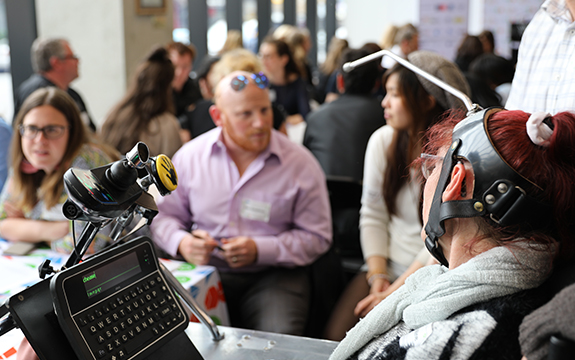Makers team up in race to create prototypes in 72 hours

In Summary
- Volunteers collaborate to find solutions for Australians living with disabilities
- Swinburne to host TOM Makeathon for second consecutive year
Close to 150 volunteers will converge on Swinburne in the first weekend of December in an attempt to create new technology for people living with disabilities in just three days.
Teams of engineers, developers, designers, health professionals and social entrepreneurs are coming together for a Tikkun Olam Makers (TOM) Makeathon, to be held at the university’s Hawthorn campus on 1-3 December.
TOM is a global movement that connects disabled people seeking help to overcome a specific challenge to a team of makers, who spend three days developing a prototyped solution.
Global impact
Swinburne Innovation Precinct foundational director Professor Sally McArthur says the ‘magic of the Makeathon’ is that solutions developed at Swinburne could improve the lives of thousands of people around the world.
'What I love most about TOM is that all of the prototypes are completely open source, meaning anyone can access the designs for free online,' says Professor McArthur.
'So, although the teams are dedicated to overcoming the challenge of one person, the impact has potential to be much more far reaching.
‘We were honoured to host the first TOM Makeathon in Australia in 2016 and are fortunate to be able to take on more challenges and welcome more teams and makers this time around.’
The teams met for the first time at Swinburne on 25 October, when they learnt of the challenges they would be unpacking at the Makeathon.
Challenges for TOM Melbourne 2017
Universal bottle pourer: Mandy McCracken is a quadruple amputee with two prosthetic hands. She has difficulty gripping various shaped bottles and accurately pouring liquids and would like to create a universal and inclusive bottle pouring system.
Independent towel drying: Harry Green has hemiparesis (weakness) on his right side as a result of his cerebral palsy. He cannot grip things with his right hand and often needs assistance from others. He would like a drying mechanism for both his front and back that he can operate independently.
Golf club grip: As a result of a sporting injury, Beau Vernon is a quadriplegic, with only some movement of his arms and no finger movement. He is a very sporty person and currently when playing golf, has to tape golf clubs to his hands. He is looking for a gripping solution so he can take clubs in and out of his bag and hold them while swinging.

Stable filming on crutches: Amy Marks is a media student living with cerebral palsy, affecting her balance and gross motor skills. She uses crutches, making carrying handheld cameras extremely difficult. She would like a solution to allow her to film steadily and independently.
Entertainment devices: Danielle Williams’ two daughters Aeli and Dali have a rare genetic condition called SYNGAP and as a result suffer a number of conditions including autism, ataxia, frequent seizures, pica and insomnia. Both girls wake in the early hours of the morning and crave interaction and attention. Danielle is looking for a robust entertainment solution that the girls can operate independently.
Smart Dog Guide Harness: Sif Dal is a dog guide handler and wants to create an adjustable handle for her dog guide harness so that she can alter its length. She would also like her harness to incorporate technology features such as GPS.
Liquid Level Measure: Alison Kershaw is visually impaired and would like a device that enables her to cook easily and safely. In particular, she would like to know how much liquid is remaining while boiling a pot.
Inclusive fishing: Andrea Milner uses an electric wheelchair controlled using a head point. When fishing with her dad, he puts the rod on her tray and helps her to reel in the fish. She is seeking to develop a technology to help her fish more independently.

Foot cursor: Cornelius Yalamu is a 12-year-old boy who has cerebral palsy. Since the age of three, he has controlled a computer mouse using his left foot. He is now after a technological device to help his brain and left foot coordinate synchronously so he can realise his dream of becoming a graphic designer.
Independent art: Lorraine Hagg has cerebral palsy and has difficulty holding paint brushes and pencils at her weekly art class. She currently uses a strap that has a small insert to hold the instrument while her support worker guides her arm. She is looking for a solution to allow her to paint and draw more independently.
Engaging exercise: Brent de Josselin has Prader-Willi Syndrome, a complex genetic disorder commonly resulting in hyperphagia (excessive eating) as well as hypertonia (low muscle tone). His mother is looking for an engaging and entertaining exercise solution for Brent that incorporates incentives and challenges.

